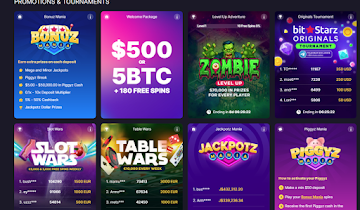5 Best Crypto Casinos 2025: Safe Bitcoin Online Casinos Tested & Approved By Local Players
| Casinos | Welcome Bonus | Best Suited For |
| JACKBIT | 100 no-wager free spins + No-KYC + 30% Rakeback | Best for High Rollers |
| BetWhale
(US, AU, & CA) | 250% up to $2,500 on casino games + 200% up to $6,000 on sports | Best for US Players |
| BitStarz | 300% up to $500 or 5 BTC + 180 free spins | Best for Provably Fair Gameplay & Fast Withdrawals |
| KatsuBet | 325% up to 5 BTC + 200 free spins | Best for Flexible Transactions & 20+ Cryptocurrencies |
| 7Bit Casino | 325% up to 5.25 BTC + 250 free spins | Best for Large Welcome Bonus |
Cryptocurrency casinos are shaping the online gambling industry for a good reason. From fast payouts to a wide variety of bonuses and a plethora of games, playing at the best crypto casinos is all you need to enjoy the best possible gambling experience. With many Bitcoin casinos boasting numerous features, we tested the big names and picked the best ones to offer you a confident and secure gameplay experience in 2025.
 Pro Tip: Choose JACKBIT for ultra-fast crypto payouts and 20+ supported coins
Pro Tip: Choose JACKBIT for ultra-fast crypto payouts and 20+ supported coins
Best Bitcoin Casino Sites: Picked for Security, Fun, and Massive Rewards
Finding the best crypto casinos that actually deliver security, fun gameplay, and alluring rewards is indeed a task. However, we’ve taken the time and courage to deliver it to our players, and here is our best crypto casino list of 2025!
Key Takeaways:
- Generous Crypto Bonuses
- Vast Game Variety
- Fast and Fee-Free Payouts
- Strong Security and Fairness
- Mobile-Optimized Experience
Best Online Crypto Casinos of 2025: 5 Top Bitcoin Online Casinos Reviewed
Here is a detailed overview of the best crypto casinos of 2025. Each casino listed here has been vetted for licensing, security protocols, and fast payouts. Dive in to know more about what’s hidden inside these top Bitcoin casinos that can level up your profitable gameplay in 2025.
1. JACKBIT: Best Crypto Casino Overall, Offering Fast Withdrawals and an Extra Layer of Anonymity
Key Highlights
- No-KYC casino with great anonymity
- Play 6,000+ casino games or bet on 100+ sports
- Mobile-friendly website with 12+ language support
- RNG certified transparency
- Cash prizes all day long, with Drops & Wins
 Welcome Bonus
Welcome Bonus
Jackbit values both casino and sports enthusiasts, and splits its welcome bonus into two.
- Casino Welcome Bonus: 30% Rakeback + 100 free spins without a wagering requirement.
- Sports Welcome Bonus: 100% cashback on first lost sports bet.
 Ongoing Promotions
Ongoing Promotions
- Lol Worlds Booster: Bet min $10 and get a 10% boost on bets won
- Champions League Cashback: Claim 20% cashback on lost bets
- US Leagues Cashback: Get 10% cashback on lost bets
- Bet Masters Sports Tournament: Claim $20,000 prize pool weekly
- Instant Games Tournament: Win a share of $500 every day
- Weekly Casino Tournament: Get a share of $10,000 every week
- Rakeback VIP Club: Instant cashback
- 3 + 1 Free Bet: Get 4th ticket as a free gift in sports
- Bet Insurance: 10% cashback as a free bet
2. BetWhale: Best Bitcoin Casino USA with $6,000 Welcome Bonus on Sports 
Key Highlights
- 4,500+ casino games, including high RTP slots and tables
- Every 24-hour updated live dealer section
- Unbeatable selection of sports, with major leagues in the US
- Fast and secure payments with no fees
- 24/7 efficient customer support
 Welcome Bonus
Welcome Bonus
Here’s how BetWhale’s welcome bonus is distributed across casino and sports games.
- Casino Welcome Bonus: 250% up to $2,500 on slots, table games, and cards.
- Sports Welcome Bonus: 200% up to $6,000 if deposited with crypto or 100% up to $1,000 with fiat currency deposits.
 Ongoing Promotions
Ongoing Promotions
- Pick A Box: Unlock the mystery prizes hidden
- Unlock Missions, Levels, and Tournaments with your first deposit
3. BitStarz: Best Crypto Casino with 500+ Cryptocurrency Acceptance and Extravagant Promotional Offers
Key Highlights
- Play high RTP casino games, including originals
- Huge range of promotional offers, including a level-up bonus
- Fire in the Hole 3 game, with 46,656 ways to win
- Weekly tournaments with dollar prizes and free spins
- Numerous Halloween games, including Halloween Boonanza
 Welcome Bonus
Welcome Bonus
Get 300% up to $500 or 5 BTC and 180 free spins on your first four deposits, which is all you want to have a great start at this best crypto casino.
- 1st deposit: 100% up to $100 or 1 BTC + 180 free spins
- 2nd deposit: 50% up to $100 or 1 BTC
- 3rd deposit: 50% up to $200 or 2 BTC
- 4th deposit: 100% up to $100 or 1 BTC
 Ongoing Promotions
Ongoing Promotions
- Bonuz Mania: Cashbacks, Piggyz Break, Deposit Multipliers, and more
- Level Up Adventure: $70,000 in prizes for every player
- BitStarz Originals Tournament: $5000 cash, among the first 500 places
- Slot Wars: €5,000 and 5,000 free spins weekly
- Table Wars: €10,000 cash, among the first 50 places
- Jackpotz Mania: Minor and mega jackpots
- Piggyz Mania: Collect Piggyz, starting from 5x your deposits
4. KatsuBet: Top Real Bitcoin Casino with Highroller Welcome Bonus and Regular Tournaments
Key Highlights
- 7,000+ game lobby, including high RTP ‘10 Lucky Spins’
- Classify games based on RTP, themes, and megaways
- Secure and safe crypto payouts within minutes
- Accredited by a certificate of trust by AskGamblers
- Strong adherence to responsible gambling
 Welcome Bonus
Welcome Bonus
4-tier welcome package with 325% up to 5 BTC and 200 free spins. Here is how the distribution goes,
- 1st deposit: 100% up to 1.5 BTC + 100 free spins
- 2nd deposit: 75% up to 1.25 BTC + 100 free spins
- 3rd deposit: 50% up to 1.25 BTC
- 4th deposit: 100% up to 1 BTC
 Ongoing Promotions
Ongoing Promotions
- Welcome Highroller Bonus: 50% match + unlimited max cashouts
- BTC Exclusive Bonus: Get 75 free spins once a week
- Pre-Release Bonus: Claim 35 free spins
- Monday Reload Bonus: Grab up to 0.0041 BTC + 50 free spins
- Wednesday Free Spins: Get 35, 75, or 100 free spins
- Thursday Loot Box: Open the loot box to get 45, 85, or 100 free spins
- Weekend Bonus: Exclusive weekend offers
- Daily Cashback: 5%, 7%, or 10% cashback for the previous day’s losses
- Birthday Bonus: Get a guaranteed birthday present from KatsuBet
5. 7Bit Casino: Best Crypto Casino with Massive 250 Free Spins Welcome Bonus and Diverse Payment Options
Key Highlights
- Top Bitcoin gambling site with 10,000+ casino games
- 325% and 250 free spins welcome bonus
- Halloween special Jackpot Bats tournament, with just 0.01 USD
- Telegram exclusive bonuses and weekend free spins
- Instant payout casino, with 10+ cryptocurrency acceptance
 Welcome Bonus
Welcome Bonus
Offering one of the highest welcome bonuses in the crypto casino industry, ie 325% up to 5.25 BTC, and 250 free spins, 7Bit is loved by every player.
- 1st deposit: 100% up to 3.44 mBTC + 100 free spins
- 2nd deposit: 75% up to 5.16 mBTC + 100 free spins
- 3rd deposit: 50% up to 3.44 mBTC
- 4th deposit: 100% up to 34.4 mBTC + 50 free spins
 Ongoing Promotions
Ongoing Promotions
- Pre-Release Offer: Get 35 free spins
- Wheel of Fortune: Spin the wheel to receive random rewards
- Weekly Cashback: Get up to 20% cashback
- Wednesday Free Spins: Collect 35, 75, or 100 free spins
- Telegram Offer: 50 (joining), 111 (Friday), or 66 (Sunday) free spins
- Monday Reload Bonus: 25% up to 4.3 mBTC + 50 free spins
- Birthday Bonus: Get crypto deposit bonuses or free chips
Top Games at Best Crypto Casinos: Apply Our Tips to Boost Your Winnings
Best crypto casinos host a vast range of games that cater to all types of players and every budget. Though the games at different sites vary, here are the most popular games you can find at top Bitcoin gambling sites.
Are you an experienced player? Don’t skip, we have some tips to boost your wins at these games!
1. Slots
Offering a variety of themes, features, and RTP, slots are one of the most searched games at the best crypto casinos. From classic 3-reel slots to video slots and megaways, you can choose from a variety of collections.
 How to Play: Place the bet, spin the reel, and collect the payout if the reel stops on a winning combination.
How to Play: Place the bet, spin the reel, and collect the payout if the reel stops on a winning combination.
 Pro-Tip: Choose high RTP and low volatility slots for frequent and consistent wins.
Pro-Tip: Choose high RTP and low volatility slots for frequent and consistent wins.
2. Blackjack
One of the most common table games available at the best crypto casinos. Apart from traditional blackjack, you can play numerous variants, including Multi-hand Blackjack, VIP Blackjack, etc.
 How to Play: Place your bets, and decide to ‘hit’ or ‘stand’. The ultimate goal is to beat the dealer without going over 21. You could win up to 2x of your bets.
How to Play: Place your bets, and decide to ‘hit’ or ‘stand’. The ultimate goal is to beat the dealer without going over 21. You could win up to 2x of your bets.
 Pro-Tip: Read rules regarding double-downs, splits, and surrender; these vary significantly across different versions and greatly impact your winning potential.
Pro-Tip: Read rules regarding double-downs, splits, and surrender; these vary significantly across different versions and greatly impact your winning potential.
3. Roulette
Comparably, a simple classic table game, Roulette, blends perfectly with crypto gambling, where you can bet on numerous variants such as American, European, and French roulette with your favourite cryptocurrency.
 How to Play: Place inside (numbers, up to 35x payout) or outside bet (colours, even/odd, up to 3x payout) and wait for the ball to land in the winning combinations.
How to Play: Place inside (numbers, up to 35x payout) or outside bet (colours, even/odd, up to 3x payout) and wait for the ball to land in the winning combinations.
 Pro-Tip: Check rules and payouts across different variants to choose the one that caters to your requirements.
Pro-Tip: Check rules and payouts across different variants to choose the one that caters to your requirements.
4. Baccarat
Baccarat is a banking game with a low house edge, meaning the chances of receiving large payouts are high. Mini Baccarat, European Baccarat, No-commission Baccarat, etc, are the different variants you can play at online casinos that accept Bitcoin.
 How to Play: Place a bet on the banker, player, or tie, and the hand that gets closest to nine first, without going over, wins the game.
How to Play: Place a bet on the banker, player, or tie, and the hand that gets closest to nine first, without going over, wins the game.
 Pro-Tip: Placing a bet on the banker has a higher probability of winning than a player or a tie bet. Tie bet has the least winning probability.
Pro-Tip: Placing a bet on the banker has a higher probability of winning than a player or a tie bet. Tie bet has the least winning probability.
5. Poker
Poker is one of the most strategic games at crypto casinos. With a varying number of cards and slightly different rules, you can play a wide variety of poker variants, including Texas Hold’em, Omaha Poker, Caribbean Stud, Three-card Poker, etc.
 How to Play: Place a bet, receive the cards, and form the best combination of cards dealt.
How to Play: Place a bet, receive the cards, and form the best combination of cards dealt.
 Pro-Tip: Instead of playing too many cards, try playing a few cards with great aggression. Also, use a poker cheat for quick reference.
Pro-Tip: Instead of playing too many cards, try playing a few cards with great aggression. Also, use a poker cheat for quick reference.
6. Bitcoin Games
Crash, Plinko, and Dice are some of the common BTC games available. These games add fun to crypto gambling while offering high payouts.
Crash: Players place a bet and watch the multiplier. The goal is to cash out before the crash. The longer you hold, the higher the payout you receive.
Plinko: A provably fair game, where a ball is dropped in a triangular board and lands in one of the many payout slots. Players can adjust the risk level and number of rows, making it suitable for both beginners and high rollers.
Dice: Playing Dice at crypto casinos allows you to verify the game outcome using provably fair. Bet on whether the dice will land on a specific number or a combination, and receive payouts for the right outcomes.
Best Crypto Casinos: Final Thoughts
Transforming how payouts are processed and games are verified, the blockchain-based crypto casinos have become a pillar of the online gambling industry. From fast payouts to most rewarding bonuses and provably fair games, the features that were once a dream are now put together in front of players in the best crypto casinos.
The top crypto casinos listed above are fully legitimate and tamper-proof, and with time, more features such as welcome bonuses up to $30,000, high cashbacks, etc, can be expected. Be an early player at these casinos and level up your games and profits.
Frequently Asked Questions on Best Crypto Casinos
1. How long do withdrawals take at the best crypto casinos?
The average time required for payouts to reach your crypto wallets is generally 1 to 10 minutes.
2. Which is the best offer a high-stakes player can claim at Bitcoin casinos?
Bitcoin casinos offer VIP programs exclusively for high rollers and active players, providing attractive rewards such as high betting limits, high withdrawal limits, and personalised customer support.
3. How to select the best no-deposit bonus at crypto casinos?
The best no-deposit bonus is the one that offers the largest bonus amount with the lowest wagering requirements.
4. Which is the best instant withdrawal no-KYC casino?
Jackbit is the best instant withdrawal no-KYC casino you can play in 2025.
5. Are all crypto casinos provably fair?
Most crypto casinos are provably fair, allowing you to verify the game outcomes yourself.
The post 5 Best Crypto Casinos 2025: Safe Bitcoin Online Casinos Tested & Approved By Local Players appeared first on Live Bitcoin News.
You May Also Like

Bitcoin White Paper: A Peer-to-Peer Cash System

ASTER is on the Crypto Market’s Spotlight: Huge Whales Are Very Active
